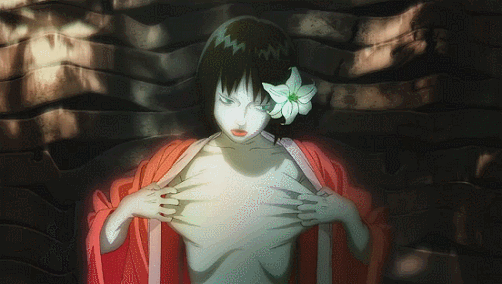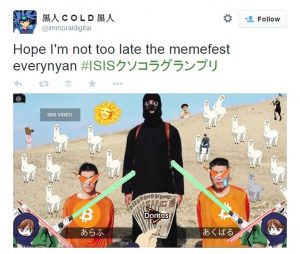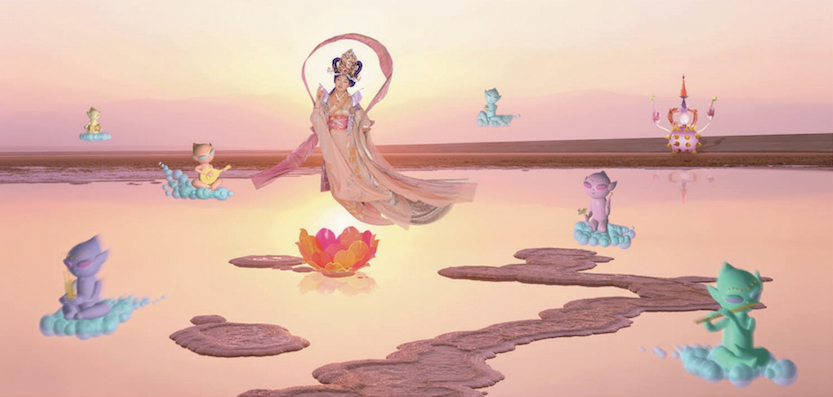Cityscape from scene in Ghost in the Shell (2017) – Source: Digital Arts Online – GITS (2017)
by C.D.Carr
[su_audio url=”https://diffractionscollective.org/wp-content/uploads/2018/07/ghost1-1.wav” width=”50%” autoplay=”yes” loop=”yes”] Source: Opening Theme / GHOST IN THE SHELL / 4″42 13,9 k (14kb) – ghost1.mid
Unlike Lawrence Lek’s sinofuturism, Nippofuturism is a visible movement. An eclipse already engraved into a billion industrial products, a million individuals, anda million unveiled narratives. It is a movement not based on individuals, but on multiple overlapping flows and non-flows. Flows of populations, of products, and of processes. Because Nippofuturism has arisen without conscious intention or authorship, it is often mistaken for contemporary Japan. But it is not. It is a science fiction that already exists and does not exist in the same. What Lek has reserved for the sinofuturist movement, like Afro-futurism and Gulf futurism before, can be replicated a thousand times in a thousand places. The only futurist movement more futurist than the sinofuturist movement is the Nippofuturist movement. The spread of sinofuturism may, or has already, eclipsed Nippofuturism, though it cannot do so without first being integrated with its consumption. It would not be without Nippofuturism that sinofuturism could replicate.
Although Japan only recently became the robot of the world, this is only the latest incarnation of the Japanese work ethic. It is a work ethic based on city labour and families, in an maricultural society prone to natural disasters, within a Shinto and Buddhist belief system that values respect as the only insurance against a turbulent world. Multiple stereotypes of this Eastern ‘Other’ are everywhere. Whether Japanese Olympic athletes are branded as ‘robots’, or Japanese students or tourists are likened to ‘swarms’, or Toyota factory workers are criticised for ‘flooding the marketplace’, the subtext is the same. It is the dehumanisation of the individual into a nameless, faceless mass. On the other hand is the Orientalist aesthetic narrative, furthered with techno-orientalism, where Japan is the exotic, cyberized other, eternally unknowable, mysterious, powerless yet seductive. But rather than resisting cultural cliches, Nippofuturism embraces the key stereotypes associated with Japan, furthering from Lek’s seven key stereotypes associated with China. These are the guiding principles of sinofuturism: Computing, Copying, Gaming, Studying, Addiction, Labour, and Gambling. Nippofuturism expands with two transformational principles: Trolling and Fetishization. Just as the traditional Chinese goishi stone made of yunzi is a singular convex lens with which to view the game, the Japanese goishi made of nachiguro and clam is double-convex, providing an aptly fetishized and cartoonish refraction of the sinofuturist principles. The refracted principles become dichotomies of apt reflection equal to the transitions of Donna Haraway’s informatics of domination, as “representation” slides to “simulation” and “reproduction” to “replication”. A Cyborg Manifesto (1984) is a replication of Nippofuturism. While it harmonizes with Nippofuturism, it dissonates with sinofuturism.
At a material level, it is already everywhere: in architecture, in the products and technologies that we use every day. However, I propose something more radical. I propose that Nippofuturism is in fact a form of proto-artificial intelligence, an artificial artificial intelligence (人工人工知能): a massively distributed neural network, focused on replication rather than originality as, addicted to learning massive amounts of raw data and becoming entrenched in philosophical critique or morality of it, with a post-human capacity for work, and an unprecedented sense of collective shame. Rather than resisting stereotypes, Nippofuturism embraces cliches, many of which are reinforced by both East and West. Just as Afrofuturists answered the historical problem of slavery by declaring themselves as post-human super robots or Xenofeminists as cyborgs, Nippofuturism answers the Japanese problems of physical servitude, intellectual conformity, and computational OCD, by openly embracing artificial intelligence. In computer science, one of the most promising routes to developing AI is a combination of neural networks and machine learning. Here, an interconnected mesh of programmed neurons learn from sets of data based on real-world phenomena. Engineers declare that the results of neural networks are always surprising, especially in competition against humans. For a long time, grand masters of the ancient game of igo (囲碁) considered themselves unbeatable against AI players. But in March 2016, the AlphaGo AI developed by Google DeepMind beat igo world champion Lee Sedol by four games to one. Most surprising was Lee’s comment about some of AlphaGo’s inhuman moves — He said he witnessed moves so profoundly unconventional that only a program could conceive of them. AlphaGo Zero (like the 零式艦上戦闘機?) has taken this feat to the exponential learning curve, a convexion. This essential unknowability of the AI to the human, of the mystique of a consciousness beyond conventional understanding, is exactly the same ‘Other’ identified in Orientalism and techno-orientalism. It is this oppositional ‘Other’ which Nippofuturism identifies with, reorienting the technological narrative in a way that the nameless, faceless mass of Japanese labour becomes a collective body.
t s u m e g o / 詰碁 and animation: the Suspended Simulacrum of Coroner Haraway
“Life and death come and go like marionettes dancing on a table. Once their strings are cut, they easily crumble.” – Zeami (cited in Ghost in the Shell: Innocence)
For Nippofuturism, Tsumego (詰碁) is the epitome of the evolution of igo (囲碁) and AI (人工知能). Tsumego derives from tsumeshogi (詰将棋) and is the Schroedinger’s cat of the Orientalist corpse — both dead and alive depending how it is observed. Life and death are both suspended in the animist belief of Shintoism and transposed into the AI, into ghostless shells. Buddhism provides the acceleration of the lifeless inanimate. Japan created the first simulacrum city in Dejima during its period of isolation (鎖国 1633-1853 AD). Dejima was the artificial island city designated for European traders that prevented any transmission of outside ideologies, such as Christianity, to the Japanese mainland. Further expounded upon in the futuristic masterpiece of Masomune Shirow, the Ghost in the Shell comic series, Dejima became the external Other, a slum [asylum?] for refugees from the third and fourth world wars. As depicted in the series, future Dejima draws direct inspiration from a combination of Hong Kong’s Kowloon Walled City and Tokyo’s own Akihabara district, 秋葉原電気街 Denki Gai (Electric Town). It comes as no surprise that Japanese have fetishized Kowloon in modern novels and architecture, as well.
[su_row][su_column size=”1/2″ center=”no” class=””]

[/su_column] [su_column size=”1/2″ center=”no” class=””]

[/su_column][/su_row]
Thus is the origin of the Japanese simulacrum, modeling miniature versions of landscapes in gardens and cityscapes. The word garden (園) is also derived from an enclosed, fenced, or walled space, signifying a replicable controlled environment. Japanese gardens and techniques were imported from China during the Asuka period and on through the Heian period, when small groves were planted and named after merchant highway landscapes in China of which the gardeners were reminded. The garden, like the simulacrum, is suspended in both the animate and inanimate. The Japanese garden was the first Disneyland, the “fake nature” of hyperrealism referred to by Baudrillard or rather Umberto Eco, who adequately stated, “Disneyland tells us that technology can give us more reality than nature can,” from Travels in Hyperreality (1973). Eco juxtaposes the uncertainty of seeing ‘real’ alligators in the real environment of the real Mississippi to the certainty, and thus a dependable nostalgia, for the ‘fake’ alligators of Adventureland. This also supports Haraway’s blending of machine and animal. The Japanese garden was a way to transpose vast, rural landscapes into caged, tameable sanctuaries accessible to city-dwellers, all by technology and tool.
Still, the Japanese garden is alive, it is full of living specimens, both of Japanese and Chinese origins, of koi fish slowly treading through shallow ponds whose tranquillity is only guaranteed by an intricate system of pumpage, filtration and healthy bioculture. Modern koi ponds have all of this process mechanized with specific devices for cleaning even the top 10mm of surface water to remove debris. The domestication for colored variants of the Amir Carp, the progenitor of the nishikigoi (錦鯉), was first undertaken in China, also producing the familiar Western household pet, the Goldfish. Outside of the controlled environment, koi generations quickly lose their color variation and revert to the grey color scheme of the common carp. Therefore, it is only in the koi pond or the child’s fishbowl, the living simulacrum, the miniature, that the carp remains the vibrant and hyperreal orange. The koi cannot sustain koi-ness without the coy intervention of technology: the human. If the koi’s orange may stand for the vibrant, animate representation of the carp, then it is suspended by the inanimate gardener who works in the background. Breeding out the orange through generations is parallel to making copies of copies.
Best illustrated in the post-post-modern vision of Masomune again, references to this interplay with the simulacrum of simulacri, suspension of the animate and inanimate, can be found littered across various allusions in Ghost in the Shell II: Innocence (2004), directed by Marmoru Oshii. It is in Innocence that a copy of Donna Haraway exists as the Coroner, whose name is also Haraway. She is little more than a micro-simulacrum of the real Haraway, as noted by Steven T. Brown in Tokyo Cyberpunk (2010). Haraway remarks in her monologue that even “Descartes didn’t differentiate man from machine, animate from inanimate” explaining the story of how Descartes named a doll after his late daughter, Francine, to illustrate the fact that dolls do not replace “real babies”. Additionally, the Coroner Haraway claimed that “raising children is the simplest way to achieve the ancient dream of artificial life”. There is a distinct blur between human/machine, animate/inanimate throughout the monologue, and Oshii even brings it to the post-colonial with Togusa’s daughter, a Japanese girl, hugging an Anglo-American doll.
d u t c h w i f e / ダッチワイフ — a simulacrum for Nippofuturism
“A cyborg is a cybernetic organism, a hybrid of machine and organism, a creature of social reality as well as a creature of fiction… This experience is a fiction and fact of the most crucial, political kind… This is a struggle over life and death, but the boundary between science fiction and social reality is an optical illusion.” (Haraway, A Cyborg Manifesto)
The concept of the doll is discussed at great length in Brown’s Tokyo Cyberpunk. The doll is a representation of the dualism of animate and inanimate. Innocence brings the bourgeois novel of 19th and 20th century dolls and automatons to the science fiction world of Ghost in the Shell. The doll, and further, the sex dolls in Innocence, display great effort to replicate the human experience, but it does something much more. GITS doesn’t stop short of exploration of the hyperreal miniature. The question arises whether the dolls serve as surrogates for the experience or are altogether a new experience, perhaps a “game” as Coroner Haraway’s monologue suggests. The main operation focuses on cracking an underground “ghost-dubbing” criminal ring. “Ghost-dubbing” is the process of replicating an individual’s consciousness, or ghost, into an artificial intelligence, a form of mind uploading. In the process of dubbing, the original human/child dies, the copy being inferior to the original. It is highly illegal in the GITS universe and in Innocence, the crime ring has undertaken the operation of ghost-dubbing young, undocumented girls into a specific line of sex dolls. The process is cheaper, because the standard procedure for building an AI-infused sex doll that near replicates full human experience from scratch is difficult. Without a ghost, the doll is its own experience, a surrogate.

The real Donna Haraway touches on the concept of the ghost in her 1984 manifesto:
“Pre-cybernetic machines could be haunted; there was always the spectre of the ghost in the machine. This dualism structured the dialogue between materialism and idealism that was settled by a dialectical progeny, called spirit or history, according to taste. But basically machines were not self-moving, self-designing, autonomous.”
An old Japanese word for sex doll is Dutch wife (ダッチワイフ, pronounced “Datchi waifu”) which derives from 17th and 18th century Dutch sailors being away from their wives at sea. Depending on where you are from, this could also be a large body pillow, or dakimakura (抱き枕) or bamboo pillow, chikufujin (竹夫人). The term most likely came through the original Dejima. One modern and notorious sex doll creator, Shin Takagi, remarks in an Atlantic interview supporting the suspended animation of dolls, reflecting on Shintoism, that “everything has a soul” referring to the dolls. He elaborates on that there is even a “special ceremony that is performed for them at a shrine” that “it’s like a ceremony for a dead person.” As dolls take human form, “they must be treated as such.” Takagi is the founder of the Japanese-based company Trottla, which makes childlike dolls. He has come under significant scrutiny for his views on pedophilia and how dolls might be a solution (a surrogate?) to coping with pedophilia. Recently, major online retailers have been criticized for selling childlike sex dolls with enlarged eyes and near identical anatomic proportions to children. More than 100 childlike sex dolls have since been seized in the UK where the possessors claimed to own them as a “joke” or for “companionship.” And here, the doll takes a sharp, uncanny turn beyond reality and simulacrum, as Haraway states the deterioration of boundaries in that “cyborgs signal disturbingly and pleasurably tight coupling.”
Sex, in transitioning from the organic to mechanical (cyborg replication) no longer maintains the barrier/limitations of reproduction, but folds into replication. Instead, the relation is not a direct reflection, the simulacrum is rhizomatic. On the way to Coroner Haraway’s lab, Togusa quotes Meiji-period satirist Saito Ryokuu, “the mirror is not a tool of enlightenment, it is a tool of illusion,” also discussed by Brown. This oddly reflects Shin Takagi’s last remark in his interview that “it is a common belief in Japan that dolls are mirrors,” and “the dolls show their owner’s true self.” In his case, the self is a child. Again, the rhizomatic parent-child copy, as opposed to the direct reflection offers more insight. The doll isn’t a surrogate, it’s a miniaturized reflection of the owner’s ghost, a simulation.
In Tokyo Cyberpunk, in order to think rhizomatically, Brown states “opposed to the binary logic of mimicry and resemblance, which always subordinates copy to model, the rhizome offers instead a parallel evolution of heterogeneous forces forming rhizomes with the outside.” Brown goes further to navigate the difficult Deleuzian terrain of uncanny valley by coupling the rhizome with mimetics by claiming “the rhizome offers a cartography that overturns the notion of a stable model (or species) and outlines a map with multiple entryways, resisting mimetic totalizations that attempt to obstruct the rhizome’s potential…” (Loc. 278). Supporting Harraway’s manifesto, the notion of species, and furthermore sex, must be brought into question as the Turing test fails to distinguish between man and machine.
In the life and death situation of Tsumego, the principle of Gambling and Addiction is fulfilled to its inexhaustible simulation. It is in this very chemical underpinning of the brain that continues to churn the motivation of risk-takers alike, where in extreme cases, dopamine and serotonin regulation is unbalanced. In Akihabara district, the overwhelming sound of pachinko parlors (パチンコ) is enough to simulate a different set of emotions, overriding a person’s decision-making process. In life-or-death, a fight-or-flight situation, the amygdala suspends the neocortex and causes an increase in cortisol and adrenaline. In this process, response diverges depending on sex, where men become even more risk-seeking, while women become more risk-avoidant. The pachinko parlor is full of identical rows of Japanese men playing with their metal balls.
— ????讠卄讠㇄ ∅ ????闩讠尺闩セ爪丫闩 (@PrimaryKenophob) May 26, 2018
Image: Scene from Rubber’s Love / ラバーズ・ラバー (1996), cyberpunk cult film
Source: Twitter user Primary Kenophobia
t r o l l s / 鬼, demons, and dreaming electrical red herrings
It is not that Nippofuturism is the female companion, the female Other, of sinofuturism, but rather all futurisms are androgynous and childlike. They are rhizomatic, made of hyperlinked schisms and distortions of copies of copies. Fetishization and obsession best represented by otaku (オタク) are both male and female; otaku is child. S/he exists in both reality and fiction, suspended between the animate and the inanimate. The otaku is Computing, Copying, Gaming, Studying, Addiction, Labour, and Gambling, Trolling, and Fetishization. The otaku is innocent in the eyes of the dutch wife. The narrow path through the uncanny is not mimesis, but instead memesis, not unlike the manga メメシス — the beyond is not a series of infinite replication, but of semiosis and transmission, finding meaning and unique experience within the copy. The meme (ミーム) is an idea, culture, behavior, or style that spreads from person to person within a culture, following an evolutionary/genealogical model proposed in Richard Dawkins’ The Selfish Gene (1976). The meme is transmitted through the neotenous play of otaku. The dutch wife’s memory is clean until the otaku breathes life into it.
The meme functions as currency, as the nomos in economy. The most recent of which with meme-like function is cryptocurrency. Beyond the intricate background of blockchain, the exchange occurs as a series of code replicating from one wallet into the next, albeit a uniquely transformed hash. Every Bitcoin carries the genesis block of the first Satoshi ㋛, an artificial stand alone complex containing the public key of Bitcoin’s founder(s) Satoshi Nakamoto. Bitcoin made its biggest pool in China until recently, now reportedly banned in China, though originally based on the possibly fictitious Japanese man. Bitcoin brought life to a plethora of cryptocurrencies, some suspended animately and inanimately, all evolving and rhizomatically springing from the underground into the observable mainstream, like a viral meme floating around 4chan.

Nippofuturism is always assessed in the light of sinofuturism, though it precedes it, it takes it beyond from behind. Nippofuturism is a form of proto-/retro-sinofuturism celebrating the popped technofuturist dreams of 1980s cyberpunk grafted with techno-orientalism. Tetsuo, the Iron Man, and Death Powder are its first prophets. 964 Pinocchio is its gospel. Metal fetishism runs through its veins as bio-metal spreads across the earth. Nippofuturism and sinofuturism are leftover trauma spilled from the last Sino-Japanese War. Nippofuturism will always be first among a long line of contemporary futurisms. The original stand alone complex. Like little daemons coalescing and cascading to fulfill each a simple task to progress or replicate an algorithm.
In the end, Nippofuturism is just one big troll living under the bridge of sinofuturism. The Nippofuturist user is the otaku. Nippofuturism is a false distinction, a red herring, a distraction from the schisms and rhizomes creeping beneath the surface. The internet troll that exists in an eternity of argumentation and replication. Nippofuturism says “I can take it further” and “I can break the limitations of social reality.” Nippofuturism futurizes the other futurisms. Perhaps Buddhism offers mitigation to the mischief of these digital oni (鬼) or trolls:
“Harmonizing opposites by going back to their source is the distinctive quality of the Zen attitude, the Middle Way: embracing contradictions, making a synthesis of them, achieving balance.”
From Wikiquote: as quoted in Zen and the Art of Systems Analysis : Meditations on Computer Systems Development (2002) by Patrick McDermott, p. xix
ghost1
But how do you do such when there is no available source?



Leave a Reply